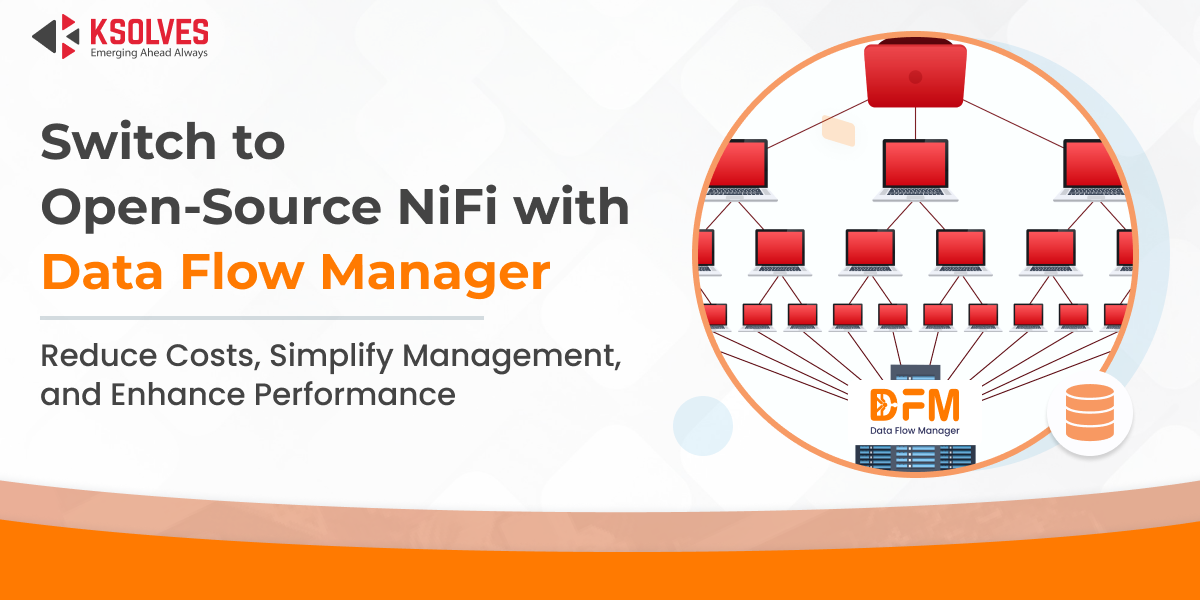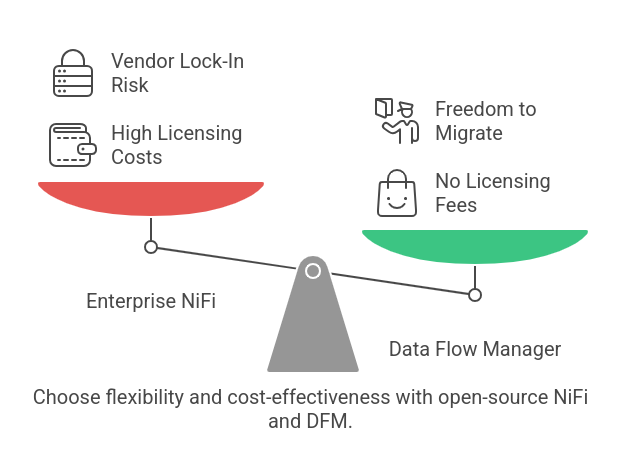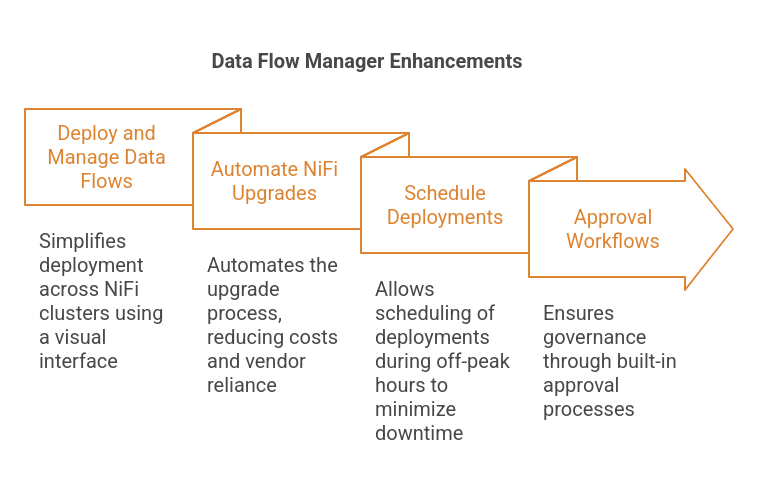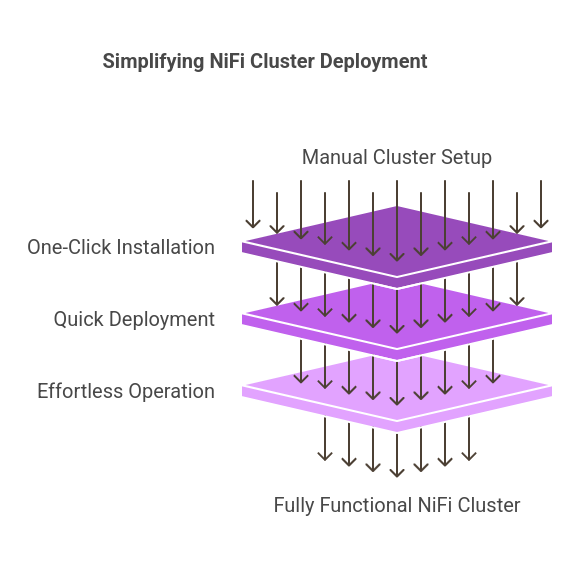How Data Flow Manager Cuts Enterprise NiFi Costs Without Compromising Performance
![]()

Apache NiFi is a powerful tool for managing data flows and getting real-time insights. However, enterprises often spend heavily on licenses, infrastructure, and maintenance. These costs may seem justified for extra features and vendor support—until you realize that with the right open-source approach and smart automation, you can achieve the same results at a much lower cost.
This comprehensive guide explores how Data Flow Manager (DFM) — the first-ever UI-driven NiFi and data flow management tool that comes with a NiFi Control Portal – enables organizations to cut costs without compromising performance.
In this blog, you’ll discover how Data Flow Manager helps in:
- Eliminating high licensing fees
- Automating manual, error-prone tasks
- Seamlessly scaling NiFi clusters
- Maintaining enterprise-grade security and governance
All this, at up to 75% lower costs compared to typical enterprise NiFi solutions.
The Hidden Costs of Enterprise NiFi: What You Need to Know
1. Expensive Licensing Fees
Many enterprise NiFi providers charge subscription fees that increase with each new node or user. As your data or user base grows, these costs can quickly become too expensive to sustain.
2. Infrastructure & Maintenance Costs
Running large NiFi clusters requires specialized infrastructure and expertise for setup, optimization, and maintenance. The costs increase further when relying on vendor-managed support, which often comes with hidden fees and slow response times, making operations more expensive.
3. Limited Flexibility for Scaling
Enterprise NiFi licensing is often rigid, forcing businesses to pay for additional nodes or resources even when their usage fluctuates. This lack of flexibility results in higher costs, especially during periods of low demand when resources sit idle.
4. Slow Response Times for Support
Despite paying a premium for enterprise support, response times for critical issues can stretch to several days. This delay can lead to prolonged downtime, lost productivity, and even SLA violations, making it an expensive trade-off.
5. High Maintenance Overhead
Enterprise NiFi deployments often require high-end infrastructure that meets specific vendor guidelines, driving up hardware, network, and storage costs. Additionally, maintaining a complex NiFi setup demands skilled professionals, which can further increase operational expenses.
How Data Flow Manager Reduces Enterprise NiFi Costs Without Performance Loss
1. Eliminates Costly Licensing Models
- 100% Open Source NiFi
Data Flow Manager is built on open-source Apache NiFi, eliminating subscription and per-node licensing fees that enterprise NiFi distributions typically charge. This allows you to scale without worrying about rising licensing costs.
- Freedom from Vendor Lock-In
Enterprise NiFi solutions often bundle proprietary extensions, specialized connectors, or vendor-specific configurations, making migrations painful and expensive. With Data Flow Manager and open-source NiFi, you can maintain full ownership of your data flows and clusters. This significantly reduces long-term licensing and renewal expenses.

2. Automates Deployments, Upgrades, and Maintenance
- UI-Based NiFi Deployment
Deploying and configuring NiFi manually can be time-intensive and require niche skill sets. Data Flow Manager simplifies this process with a UI-based interface that drastically cut the time – and thus the cost – of getting your NiFi clusters up and running.
- UI-Based NiFi Data Flow Deployments
Data Flow Manager makes it easy to deploy and manage data flows across NiFi clusters through a visual interface. This elimiantes the need for manual import/export process and complex configurations. Also, it reduces the likelihood of human errors.
- Automated NiFi Upgrades
Upgrading enterprise NiFi often involves costly professional services. Data Flow Manager automates these tasks, allowing your team to roll out new NiFi versions seamlessly without vendor intervention. This boosts agility and eliminates additional upgrade costs.
- Scheduled Data Flow Deployments & Approval Workflows
Data Flow Manager lets you schedule data flow deployments during off-peak hours, reducing the likelihood of downtime. Plus, built-in approval workflows enhance governance by ensuring each change goes through the right checks—saving you from costly rollbacks and compliance headaches.

3. Centralizes Cluster Management
- One-Click NiFi Cluster Installation
Setting up a NiFi cluster manually can be complex and time-consuming. Data Flow Manager simplifies this with a one-click installation process, allowing you to deploy fully functional clusters quickly and effortlessly.

- Unified Dashboard
Managing multiple NiFi clusters typically requires specialized tools or multiple interfaces, each with its own learning curve. DFM’s centralized UI helps teams manage all NiFi environments—on-prem, private cloud, or hybrid setups—in one place. This saves significant administrative overhead and training costs.
4. Flexible Deployment Models
Whether you run NiFi in on-prem virtual machines, containers, or across multiple clouds, Data Flow Manager is environment-agnostic. You can scale your data flows horizontally or vertically to match seasonal demands or sudden spikes in data ingestion. This prevents you from overpaying for peak capacity that remains idle most of the year.
5. Substantial Reduction in Manual Labor & Downtime
- No-Code Deployments
Data Flow Manager’s user-friendly, UI-driven interface does away with the need for specialized DevOps scripts or large engineering teams. Non-technical teams can also deploy and monitor NiFi flows with minimal training. This lowers the operational labor costs typically tied to manual NiFi data flow management.
- Automated Error Handling & Rollback
Complex NiFi clusters can break if misconfigured. Data Flow Manager has built-in error handling and rollback capabilities, significantly cutting the time it takes to identify and fix problems. Faster issue resolution translates directly into reduced downtime costs and higher availability for your mission-critical data pipelines.
- Scheduled Maintenance Windows
By automating patches and upgrades, Data Flow Manager enables your organization to plan updates during specific maintenance windows – leading to fewer disruptions in high-traffic or business-critical periods. In industries with strict SLAs (Service Level Agreements), reducing unplanned downtime or suboptimal performance can save millions in potential penalties.
6. High-Efficiency Monitoring & Alerts
- Real-Time Performance Insights
Data Flow Manager includes real-time dashboards that let you visualize processor usage, queue lengths, and cluster health metrics. Having these insights at your fingertips helps you spot bottlenecks and optimize data flows on the fly—preventing small issues from turning into costly service outages.
- Proactive Alerts
Set thresholds for CPU, memory, or queue size. As soon as these thresholds are breached, Data Flow Manager triggers alerts, giving your operations team the opportunity to address concerns before they escalate. This proactive approach helps maintain optimal performance and mitigates the risk of downtime.
7. Robust Security & Compliance Without Added Fees
- Role-Based Access Control (RBAC)
Enterprise NiFi offerings often charge extra for advanced security features. With Data Flow Manager, RBAC is baked in, allowing you to assign the right permissions to the right people. This ensures compliance with data governance standards—minus the extra license cost.
- Audit Logging & Deployment History
Every data flow deployment, modification, or rollback event is logged in Data Flow Manager. These detailed records help you comply with internal policies and external regulations—saving you from potential fines or reputational damage.

8. 24×7 Expert Support & Response Times
Enterprise NiFi vendors often promise premium support but may have multi-day ticket queues. Data Flow Manager provides around-the-clock expert help, with faster escalation and resolution times. This support model is crucial for reducing the downtime that can lead to direct revenue losses.
9. AI-Powered Flow Generation & Analysis
Data Flow Manager helps generate data flows in just a few clicks by providing the source, target, and description. This drastically reduces the time spent on trial-and-error design. This feature also helps non-expert teams get started quickly and effectively, cutting down development costs.
Conclusion
Enterprise NiFi solutions can weigh you down with steep licensing fees, slow support, and rigid scaling models. By contrast, Data Flow Manager leverages open-source NiFi to cut operational costs, streamline deployments, and maintain high performance across your data flows—all without compromising on security or reliability.
- Eliminate vendor lock-in and high licensing fees.
- Automate deployments, upgrades, and monitoring to free up engineering resources.
- Scale flexibly to meet real-time data demands without per-node charges.
- Get rapid 24×7 support that keeps your data pipelines running smoothly.
In short, Data Flow Manager delivers enterprise-grade functionality at a fraction of the typical NiFi cost. It empowers organizations to focus on innovation and growth rather than budgetary and operational hurdles.
Switch to Open-Source NiFi with DFM today! Transform the way you manage NiFi flows—cut expenses, boost efficiency, and never compromise on performance. Book your personalized demo.
![]()